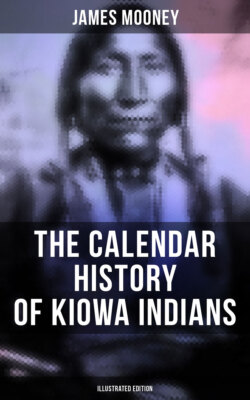Читать книгу The Calendar History of Kiowa Indians (Illustrated Edition) - James Mooney - Страница 32
На сайте Литреса книга снята с продажи.
First Official American Notices, 1805—1807
ОглавлениеTable of Contents
The earliest official account of the Kiowa is given by the explorers Lewis and Clark, who ascended the Missouri in 1804 and wintered among the Mandan, before proceeding onward across the mountains and down to the mouth of the Columbia. They do not appear to have met any of the Kiowa, but heard of them from the tribes living on the river. By that time the Kiowa, whom the explorers erroneously supposed were distinct from the "Wetepahatoes," had been driven out of the Black Hills, which were then in possession of the Cheyenne, while the Dakota held the country to the eastward. The Kiowa were then on the Padouca or North Platte. This agrees with the statements of old men of the Dakota confederacy, who informed the writer that within their early recollection that tribe had lived between the North Platte and the Niobrara, having been expelled from the Black Hills by the Dakota of the preceding generation.
The official report of Captain Lewis describes the Kiowa ("Kiawas" and "Wetepahatoes") as living in 1805 on the North fork of the Platte, and numbering 70 tipis, 200 warriors, and 700 souls, while the Kiowa Apache ("Cataka") lived somewhat farther north, on the headwaters of the two forks of Cheyenne river, and are estimated at 25 tipis, 75 warriors, and 300 souls. While the figures thus given for the Apache are probably nearly correct, those for the Kiowa are much too low, unless we assume that they had been so greatly reduced by the war with the Dakota. The alliances and wars of the two tribes, Kiowa and Apache, were the same, they carrying on a defensive war with the Dakota and being at peace with all the other tribes of the region, particularly with the Arikara, Mandan, and Hidatsa. The account continues:
They are a wandering nation, inhabit an open country, and raise a great number of horses, which they barter to the Ricaras, Mandans, etc, for articles of European manufactory. They are a well-disposed people, and might be readily induced to visit the trading establishments on the Missouri. From the animals their country produces, their trade would no doubt become valuable. These people again barter a considerable proportion of the articles they obtain from the Menetares, Ahwahhaways, Mandans, and Ricaras to the Dotames and Castapanas.... Neither these people ("Kiawas"), the Wetepahatoes, nor the Chyennes have any idea of exclusive right to the soil (Lewis and Clark, 1).
The Dotames and Castapanas (for Castahanas) here mentioned are described as living back of the Kiowa, between the head streams of the North Platte and the Yellowstone, and were probably bands of the Shoshoni. From this it appears that besides being well supplied with horses, with which they carried on a profitable trade at this period with the tribes on the Missouri, the Kiowa also acted as the trading medium between these tribes and others living in the mountains beyond the Kiowa. The officer suggests the mouth of Cheyenne river as the most suitable place to establish a trading post for them. The Crows are described as having then the same wars and friendships as the Kiowa, excepting that they were at war with the Arikara as well as with the Dakota (Lewis and Clark, 2).
The Comanche are described at this period (1805) under the name of the "La Playes" division of "Aliatans" or "Snake Indians," as inhabiting the plains from the headwaters of the Arkansas, and including the sources of Red river, and extending from the mountains eastward indefinitely. They were a wandering people, claiming no particular boundaries, and, although possessing no guns, were brave and warlike. Their country abounded in wild horses, besides great numbers which they raised themselves (Lewis and Clark, 3).
In his volume published a few years later the explorer, Zebulon M. Pike, states that the Kiowa, estimated by him to number 1,000 men, had in 1803 been driven by the Dakota into the mountains on the heads of the Platte and Arkansas and north of the Comanche, where they were then wandering. They owned immense herds of horses, were armed with bows, arrows, and lances, hunted the buffalo, and were at war with the Dakota, Pawnee, and "Tetau" (here meaning the Ute). In another place he mentions both Ute and Kiowa as living in the mountains of northern Mexico—the present Colorado and New Mexico—the former being more civilized from contact with the Spaniards. He speaks also of meeting, in 1807, a party of Kiowa and Comanche returning from a trading expedition to the Mandan (Pike, 1).
